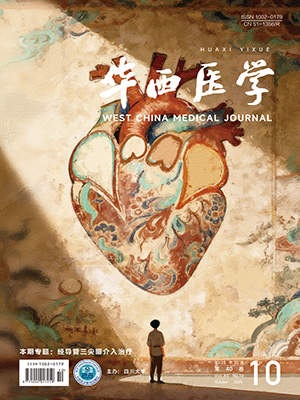| 1. |
Boldt D, Busse L, Chawla LS, et al. Anticoagulation practices for continuous renal replacement therapy: a survey of physicians from the United States. Ren Fail, 2023, 45(2): 2290932.
|
| 2. |
Ward DM, Mehta RL. Extracorporeal management of acute renal failure patients at high risk of bleeding. Kidney Int Suppl, 1993, 41: S237-S244.
|
| 3. |
van de Wetering J, Westendorp RG, van der Hoeven JG, et al. Heparin use in continuous renal replacement procedures: the struggle between filter coagulation and patient hemorrhage. J Am Soc Nephrol, 1996, 7(1): 145-150.
|
| 4. |
Uchino S, Bellomo R, Morimatsu H, et al. Continuous renal replacement therapy: a worldwide practice survey. The beginning and ending supportive therapy for the kidney (B.E.S.T. kidney) investigators. Intensive Care Med, 2007, 33(9): 1563-1570.
|
| 5. |
RENAL replacement therapy study investigators, Bellomo R, Cass A, et al. Intensity of continuous renal-replacement therapy in critically ill patients. N Engl J Med, 2009, 361(17): 1627-1638.
|
| 6. |
Fealy N, Aitken L, du Toit E, et al. Faster blood flow rate does not improve circuit life in continuous renal replacement therapy: a randomized controlled trial. Crit Care Med, 2017, 45(10): e1018-e1025.
|
| 7. |
Chua HR, Baldwin I, Bailey M, et al. Circuit lifespan during continuous renal replacement therapy for combined liver and kidney failure. J Crit Care, 2012, 27(6): 744.e7-15.
|
| 8. |
Zhang W, Bai M, Zhang L, et al. Development and external validation of a model for predicting sufficient filter lifespan in anticoagulation-free continuous renal replacement therapy patients. Blood Purif, 2022, 51(8): 668-678.
|
| 9. |
Ratanarat R, Phairatwet P, Khansompop S, et al. Customized citrate anticoagulation versus no anticoagulant in continuous venovenous hemofiltration in critically ill patients with acute kidney injury: a prospective randomized controlled trial. Blood Purif, 2023, 52(5): 455-463.
|
| 10. |
Smith SA, Travers RJ, Morrissey JH. How it all starts: initiation of the clotting cascade. Crit Rev Biochem Mol Biol, 2015, 50(4): 326-336.
|
| 11. |
尹彦玲, 赵聪聪, 胡振杰, 等. 高危出血风险患者无抗凝连续性肾脏替代治疗中 AN69 ST 膜对滤器寿命影响的研究. 中华危重病急救医学, 2015(5): 343-348.
|
| 12. |
Wong ET, Ong V, Remani D, et al. Filter life and safety of heparin-grafted membrane for continuous renal replacement therapy - a randomized controlled trial. Semin Dial, 2021, 34(4): 300-308.
|
| 13. |
Naorungroj T, Baldwin I, Eastwood G, et al. The effect of the AN69 ST100 versus oXiris® membrane on filter life during CRRT for non-anticoagulated liver failure patients. Int J Artif Organs, 2023, 46(4): 209-214.
|
| 14. |
Crosswell A, Brain MJ, Roodenburg O. Vascular access site influences circuit life in continuous renal replacement therapy. Crit Care Resusc, 2014, 16(2): 127-130.
|
| 15. |
Brain M, Winson E, Roodenburg O, et al. Non anti-coagulant factors associated with filter life in continuous renal replacement therapy (CRRT): a systematic review and meta-analysis. BMC Nephrol, 2017, 18(1): 69.
|
| 16. |
Hackbarth R, Bunchman TE, Chua AN, et al. The effect of vascular access location and size on circuit survival in pediatric continuous renal replacement therapy: a report from the PPCRRT registry. Int J Artif Organs, 2007, 30(12): 1116-1121.
|
| 17. |
Smith T, Kaufman C, Quencer K. Internal jugular central venous catheter tip migration: patient and procedural factors. Tomography, 2022, 8(2): 1033-1040.
|
| 18. |
Girardot T, Monard C, Rimmelé T. Dialysis catheters in the ICU: selection, insertion and maintenance. Curr Opin Crit Care, 2018, 24(6): 469-475.
|
| 19. |
Raina R, Sethi S, Khooblall A, et al. Non-anticoagulation pediatric continuous renal replacement therapy methods to increase circuit life. Hemodial Int, 2022, 26(2): 147-159.
|
| 20. |
Fealy N, Kim I, Baldwin I, et al. A comparison of the Niagara and Medcomp catheters for continuous renal replacement therapy. Ren Fail, 2013, 35(3): 308-313.
|
| 21. |
Kim I, Fealy N, Baldwin I, et al. A comparison of the Niagara™ and Dolphin® catheters for continuous renal replacement therapy. Int J Artif Organs, 2011, 34(11): 1061-1066.
|
| 22. |
Meier P, Meier R, Turini P, et al. Prolonged catheter survival in patients with acute kidney injury on continuous renal replacement therapy using a less thrombogenic micropatterned polymer modification. Nephrol Dial Transplant, 2011, 26(2): 628-635.
|
| 23. |
Zhou Z, Liu C, Li P, et al. A randomized controlled trial of catheters with different tips and lengths for patients requiring continuous renal replacement therapy in intensive care unit. Crit Care, 2025, 29(1): 148.
|
| 24. |
Joannidis M, Oudemans-van Straaten HM. Clinical review: patency of the circuit in continuous renal replacement therapy. Crit Care, 2007, 11(4): 218.
|
| 25. |
Davies HT, Leslie G, Pereira SM, et al. A randomized comparative crossover study to assess the affect on circuit life of varying pre-dilution volume associated with CVVH and CVVHDF. Int J Artif Organs, 2008, 31(3): 221-227.
|
| 26. |
Ricci Z, Ronco C, Bachetoni A, et al. Solute removal during continuous renal replacement therapy in critically ill patients: convection versus diffusion. Crit Care, 2006, 10(2): R67.
|
| 27. |
Davies H, Leslie G. Maintaining the CRRT circuit: non-anticoagulant alternatives. Aust Crit Care, 2006, 19(4): 133-138.
|
| 28. |
Dunn WJ, Sriram S. Filter lifespan in critically ill adults receiving continuous renal replacement therapy: the effect of patient and treatment-related variables. Crit Care Resusc, 2014, 16(3): 225-231.
|
| 29. |
Baldwin I. Factors affecting circuit patency and filter ‘life’. Contrib Nephrol, 2007, 156: 178-184.
|
| 30. |
杨滨瑜, 刘彩虹, 赵宇亮. 连续性肾脏替代治疗中的血流速度: 现状与展望. 实用心电与临床诊疗, 2025, 34(1): 136-142.
|
| 31. |
Ramesh Prasad GV, Palevsky PM, Burr R, et al. Factors affecting system clotting in continuous renal replacement therapy: results of a randomized, controlled trial. Clin Nephrol, 2000, 53(1): 55-60.
|
| 32. |
中华医学会肾脏病学分会专家组. 连续性肾脏替代治疗的抗凝管理指南. 中华肾脏病杂志, 2022, 38(11): 1016-1024.
|
| 33. |
Kleger GR, Fässler E. Can circuit lifetime be a quality indicator in continuous renal replacement therapy in the critically ill?. Int J Artif Organs, 2010, 33(3): 139-146.
|
| 34. |
丁致强, 张留平, 王越, 等. 适时再次肝素冲洗法在重症高危患者无抗凝剂 CRRT 治疗护理应用效果分析. 当代临床医刊, 2022, 35(3): 19-21.
|
| 35. |
王露聪, 周国莲, 赵娜, 等. CRRT 管路预冲完成后不同时间的肝素液浸泡对滤器寿命的影响. 医药前沿, 2024, 14(34): 14-17, 22.
|
| 36. |
Panphanpho S, Naowapanich S, Ratanarat R. Use of saline flush to prevent filter clotting in continuous renal replacement therapy without anticoagulant. J Med Assoc Thai, 2011, 94(Suppl 1): S105-S110.
|
| 37. |
李丽珠, 洪琼君, 程本坤. 生理盐水冲管在无肝素 CRRT 治疗中的效果观察. 国际医药卫生导报, 2014, 20(21): 3342-3344.
|
| 38. |
王丽君, 沈雪云, 褚志强, 等. 生理盐水冲管频率对无肝素 CRRT 治疗患者血流感染的影响分析. 中华医院感染学杂志, 2018, 28(1): 58-61.
|
| 39. |
Uchino S, Fealy N, Baldwin I, et al. Pre-dilution vs. post-dilution during continuous veno-venous hemofiltration: impact on filter life and azotemic control. Nephron Clin Pract, 2003, 94(4): c94-c98.
|
| 40. |
van der Voort PH, Gerritsen RT, Kuiper MA, et al. Filter run time in CVVH: pre- versus post-dilution and nadroparin versus regional heparin-protamine anticoagulation. Blood Purif, 2005, 23(3): 175-180.
|
| 41. |
张敏, 段棣飞, 张凌, 等. 2 种不同稀释方式在连续性静脉-静脉血液透析滤过治疗中应用效果分析. 中国血液净化, 2019, 18(12): 822-825.
|
| 42. |
张敏, 王芳, 孙献坤, 等. 置换液不同稀释方式对无抗凝连续性肾脏替代治疗体外循环寿命及小分子清除率的影响研究. 华西医学, 2022, 37(11): 1686-1689.
|




